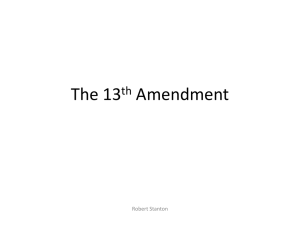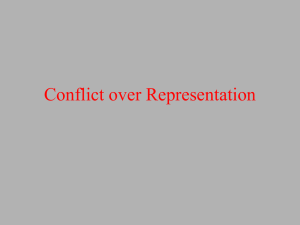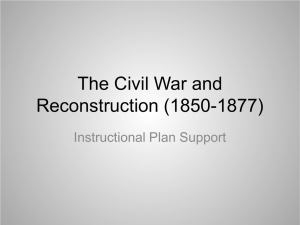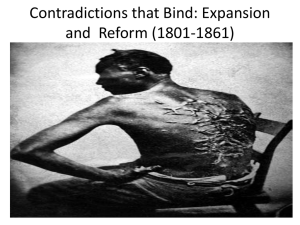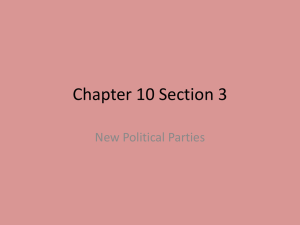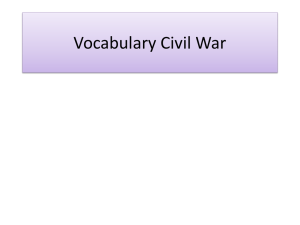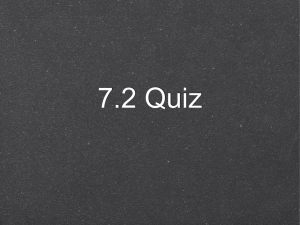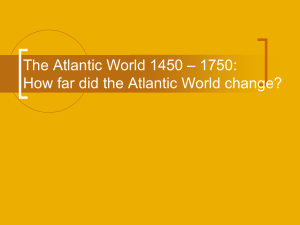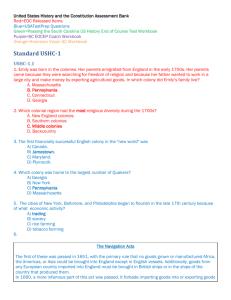US History Review
advertisement
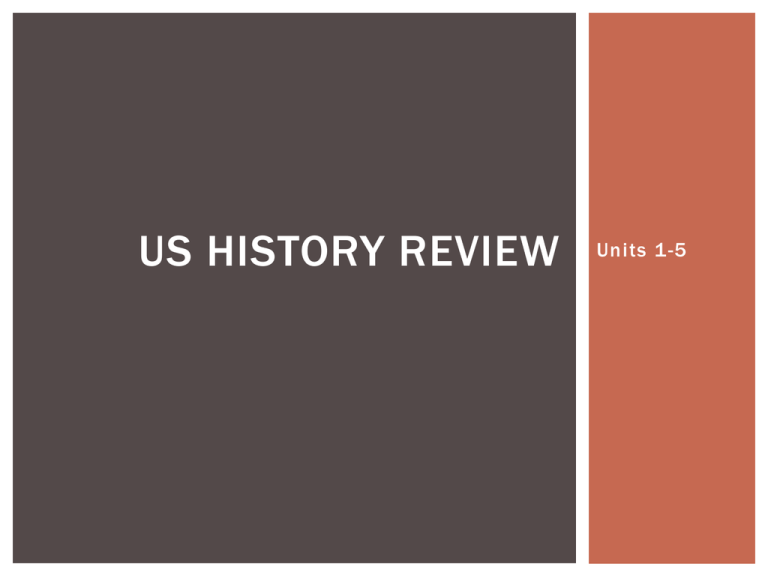
US HISTORY REVIEW Units 1-5 UNIT ONE SSUSH1 The student will describe European settlement in North America during the 17th centur y. a. Explain Virginia’s development; include the Virginia Company, tobacco cultivation, relationships with Native Americans such as Powhatan, development of the House of Burgesses, Bacon’s Rebellion, and the development of slavery. b. Describe the settlement of New England; include religious reasons, relations with Native Americans (e.g., King Phillip’s War), the establishment of town meetings and development of a legislature, religious tensions that led to colonies such as Rhode Island, the half-way covenant, Salem Witch Trials, and the loss of the Massachusetts charter. c. Explain the development of the mid - Atlantic colonies; include the Dutch settlement of New Amsterdam and subsequent English takeover, and the settlement of Pennsylvania. d. Explain the reasons for French settlement of Quebec. UNIT ONE What was the House of Burgesses? A. the home of Puritan leaders B. home of the governor of Virginia C. the Parliament in Virginia D. an elected governing body in Virginia UNIT ONE What phrase BEST describes the American colonies? A. religious purpose B. peace and stability C. successful from the start D. social equality UNIT ONE Use the information below to answer the question: Plymouth Massachusetts Pennsylvania The above are all examples of colonies A. whose primary business was plantation farming B. that signed the Mayflower Compact C. each formed by a single religious group D. formed for mostly economic reasons UNIT ONE Which DOES NOT describe Jamestown? A. It’s colonial government held the Salem Witch Trials B. In this colony, John Rolfe developed a tobacco cash crop. C. The colony was named after the king of England. D. It was the first permanent English colony . UNIT ONE Study the illustration of Jamestown’s beginnings. What details in the painting give an indication of challenges faced by the settlers? UNIT ONE SSUSH2 The student will trace the ways that the economy and society of British North America developed. a. Explain the development of mercantilism and the trans Atlantic trade. b. Describe the Middle Passage, growth of the African population, and African- American culture. c. Identify Benjamin Franklin as a symbol of social mobility and individualism. d. Explain the significance of the Great Awakening. UNIT ONE What effect did the 1808 ban on the Atlantic slave trade have on slavery in America? A. It ended slavery in the South. B. It resulted in a gradual end to slavery in America. C. It had little effect. D. It slowed the expansion of slavery . UNIT ONE Which phrase BEST describes the thirteen colonies? A. socially and politically alike B. relatively similar geographically C. politically and economically diverse D. economically independent of Britain UNIT ONE What was part of the Enlightenment? A. government as a social contract. B. restrictions of freedom C. a distrust of science D. religious equality UNIT ONE All of the following descriptions provide examples of triangular trade EXCEPT: A. the Dutch settling in Japan B. Africans being transported on ships to the Americans C. European merchants bringing manufactured goods to trade for Africans D. tobacco and other products being transported to Europe UNIT ONE Study this painting of George Whitefield during the First Great Awakening. Discuss how the structure of the New England town helped spread Christianity during the colonial era. UNIT ONE SSUSH3 The student will explain the primary causes of the American Revolution. a. Explain how the end of Anglo -French imperial competition as seen in the French and Indian War and the 1763 Treaty of Paris laid the groundwork for the American Revolution. b. Explain colonial response to such British actions as the Proclamation of 1763, the Stamp Act, and the Intolerable Acts as seen in Sons and Daughters of Liberty and Committees of Correspondence. c. Explain the importance of Thomas Paine’s Common Sense to the movement for independence. UNIT ONE What followed the Boston Tea Party? A. the free flow of trade between the colonies and other countries B. harsh restrictions on colonial liberties and trade C. increased self-government in New England D. the removal of British troops from the colonies UNIT ONE What did “no taxation without representation” mean to the colonists? A. The taxing power of British shopkeepers is represented in Parliament. B. There should be no taxation of British goods entering the colonies. C. Taxation in the colonies should only be for British citizens. D. The colonists should not be taxed without representation in Parliament. UNIT ONE Common Sense was a colonial best seller. Within three months of its publication, it sold 120,000 copies. In what way was use of the press critically important in America’s fight for independence? A. It allowed for limited debate on the subject. B. It provided the best reason to oppose the Stamp Tax. C. It provided the opportunity for many people to understand the issues. D. It contributed to greater understanding between Loyalists and Patriots. UNIT ONE Study the drawing. Discuss various methods the Sons of Liberty took to protest British taxation. UNIT ONE SSUSH4 The student will identify the ideological, militar y, and diplomatic aspects of the American Revolution. a. Explain the language, organization, and intellectual sources of the Declaration of Independence; include the writing of John Locke and Montesquieu, and the role of Thomas Jefferson. b. Explain the reason for and significance of the French alliance and foreign assistance and the roles of Benjamin Franklin and the Marquis de Lafayette. c. Analyze George Washington as a military leader; include the creation of a professional military and the life of a common soldier, and describe the significance of the crossing of the Delaware River and Valley Forge. d. Explain Yorktown, the role of Lord Cornwallis, and the Treaty of Paris, 1783. UNIT ONE How did the Treaty of Paris 1783 change the political map of North America? A. Great Britain gained land. B. The United States claimed land that had been under British control. C. France ceded Florida to Spain. D. The United States gained Florida from Spain. UNIT ONE Of what importance were men such as Marquis de Lafayette and the Baron von Stuben to the American cause? A. They served as spies. B. They provided expertise. C. They assisted the British. D. They served in Congress. UNIT ONE Use the information below to answer the question. “That whatever any form of government becomes destructive of these ends, it is the Right of the People to alter or abolish it.” These words from the Declaration of Independence describe the enlightened idea of a A. need to ensure a representative government B. return to a society that has no central authority C. social contract between the government and the people D. revolutionary intent to overthrow the current government UNIT ONE Analyze the conditions of the troops at Valley Forge(1777 -78). Then discuss how you think General Washington was able to convince his soldiers to continue fighting. UNIT ONE SSUSH5 T he student will explain specific events and key ideas that brought about t he adoption and implementation of the United States Constitution. a. Explain how weaknesses in the Ar ticles of Confederation and Daniel Shays’ Rebellion led to a call for a stronger central government. b. Evaluate the major arguments of the anti -Federalists and Federalists during the debate on ratification of the Constitution as put for th in The Federalist concerning form of government, factions, checks and balances, and the power of the executive, including the roles of Alexander Hamilton and James Madison. c. Explain the key features of the Constitution, specifically the Great Compromise, separation of power s, limited government, and the issue of slaver y. d. Analyze how the Bill of Rights ser ves as a protector of individual and states’ rights. e. Explain the impor tance of the Presidencies of George Washington and John Adams; include the Whiskey Rebellion, non -inter vention in Europe, and the development of political par ties (Alexander Hamilton). UNIT ONE What contributed to the demise of the Articles of Confederation? A. the lack of representation in Congress B. the inability of Congress to regulate the economy C. the ability to make treaties with foreign governments D. the restrictions on debate within Congress UNIT ONE James Madison commented that “A government composed of such extensive powers should be well organized and balanced.” Which of the following helped to balance power between the large and small states? A. the slave trade B. the Great Compromise C. the three-fifths compromise D. the Bill of Rights UNIT ONE Use the information below to answer the question. In a letter to James Madison written in 1787, Thomas Jefferson said “A bill of rights is what the people are entitled to against every government on earth, general or particular; and what no just government should refuse, or rest on inferences.” Jefferson believed a bill of rights was needed to protect A. the right of taxation B. the unalienable rights of citizens C. the rights of the majority D. federal rights over states’ rights UNIT ONE What did the Whiskey Rebellion show about George Washington? A. He lacked the ability to fore foreign alliances. B. He was a strong president who was willing to use federal troops when needed. C. He could not efficiently govern a nation because he was not well respected. D. He strongly believed that political parties should govern the nation. UNIT ONE How did Shay’s Rebellion highlight the ineffectiveness of the Articles of Confederation? UNIT TWO SSUSH6 The student will analyze the nature of territorial and population growth and the impact of this growth in the early decades of the new nation. a. Explain the Northwest Ordinance’s importance in the westward migration of Americans, and on slavery, public education, and the addition of new states. b. Describe Jefferson’s diplomacy in obtaining the Louisiana Purchase from France and the territory’s exploration by Lewis and Clark. c. Explain major reasons for the War of 1812 and the war’s significance on the development of a national identity. d. Describe the construction of the Erie Canal, the rise of New York City, and the development of the nation’s infrastructure. e. Describe the reasons for and importance of the Monroe Doctrine. UNIT TWO Which legislation established the procedures for the orderly expansion of the United States? A. the Northwest Ordinance (1787) B. the Louisiana Purchase (1803) C. the Adams-Onis Treaty (1819) D. the Monroe Doctrine (1823) UNIT TWO Of what significance were railroads and canals in the 1830’s? A. They slowed city growth. B. They stopped expansion. C. They encouraged westward movement. D. They improved Native American relations. UNIT TWO What was the foremost reason for the War of 1812? A. the quest for westward expansion beyond the Mississippi River B. the establishment of a representative government in America C. the French fur trade in Canada and in western United States D. the British policy of search and seizure of American ships UNIT TWO How does this political cartoon represent the message of the Monroe Doctrine of 1823? UNIT TWO SSUSH7 Students will explain the process of economic growth, its regional and national impact in the first half of the 19th centur y, and the dif ferent responses to it. a. Explain the impact of the Industrial Revolution as seen in Eli Whitney’s invention of the cotton gin and his development of interchangeable parts for muskets. b. Describe the westward growth of the United States; include the emerging concept of Manifest Destiny. c. Describe reform movements, specifically temperance, abolitionism, and public school. d. Explain women’s efforts to gain suffrage; include Elizabeth Cady Stanton and the Seneca Falls Conference. e. Explain Jacksonian Democracy, expanding suffrage, the rise of popular political culture, and the development of American nationalism. UNIT TWO Who led reform of America’s public school system in the 1800’s? A. Elizabeth Cady Stanton B. Andrew Jackson C. Eli Whitney D. Horace Mann UNIT TWO What was the importance of the Lewis and Clark expedition? A. It dismissed the idea of a water route to the Pacific Ocean. B. It established treaties with Native American groups. C. It provided boundaries of future Western states. D. It provided valuable information on Western lands. UNIT TWO What characterized Jacksonian Democracy? A. abolition of slavery B. strengthening of states rights C. expansion of the powers of the presidency D. elimination of the spoils system UNIT TWO How does this painting of a voting precinct represent Jacksonian democracy? UNIT TWO SSUSH8 The student will explain the relationship between growing north-south divisions and westward expansion. a. Explain how slavery became a significant issue in American politics; include the slave rebellion of Nat Turner and the rise of abolitionism (William Lloyd Garrison, Frederick Douglas, and the Grimke sisters). b. Explain the Missouri Compromise and the issue of slavery in western states and territories. c. Describe the Nullification Crisis and the emergence of states’ rights ideology; include the role of John C. Calhoun and development of sectionalism. d. Describe the war with Mexico and the Wilmot Proviso. e. Explain the Compromise of 1850. UNIT TWO The Compromise of 1850 conflicted with the Missouri Compromise because A. It restricted slavery to states below the MasonDixon line. B. It assured that Congress would maintain a balance of free and slave states. C. It allowed states to determine their slave status. D. It called for an end to slavery by the beginning of the 20 th century . UNIT TWO What was the outcome of the MexicanAmerican War? A. Texas became a separate nation. B. Mexico gained its independence from Spain. C. The United States annexed 500,000 square miles of territory. D. Americans began moving past the Louisiana Territory. UNIT TWO Disagreement over with political policy fueled the Nullification Crisis? A. tariffs B. states’ rights C. slavery D. voting rights UNIT TWO How did the Missouri Compromise attempt to settle the dispute over slavery between Northern and Southern states? UNIT TWO SSUSH9 The student will identify key events, issues, and individuals relating to the causes, course, and consequences of the Civil War. a. Explain the Kansas -Nebraska Act, the failure of popular sovereignty, Dred Scott case, and John Brown’s Raid. b. Describe President Lincoln’s efforts to preserve the Union as seen in his second inaugural address and the Gettysburg speech and in his use of emergency powers, such as his decision to suspend habeas corpus. c. Describe the roles of Ulysses Grant, Robert E. Lee, “Stonewall” Jackson, William T. Sherman, and Jefferson Davis. d. Explain the importance of Fort Sumter, Antietam, Vicksburg, Gettysburg, and the Battle for Atlanta. e. Describe the significance of the Emancipation Proclamation. f. Explain the importance of the growing economic disparity between the North and the South through an examination of population, functioning railroads, and industrial output. UNIT TWO What conclusion can be made about the effect of the Supreme Court ruling in the Dred Scott case? A. It received greater support in the North than in the South. B. It resulted in less need for the Underground Railroad. C. It strengthened the Fugitive Slave Law and further divided the country. D. It prompted Congress to pass new legislation protecting the rights of slaveholders. UNIT TWO Who was the President of the Confederate States of America? A Ulysses S. Grant B. Robert E. Lee C. Jefferson Davis D. John C. Calhoun UNIT TWO How did the Civil War affect the economy of the South? A. It rebounded during the war through the manufacture of war goods. B. It destroyed its infrastructure and farm fields and resulted in a shortage of goods. C. It remained steady as people went to work making clothes for the army. D. It increased the need for farm items, resulting in higher profits for farmers. UNIT TWO How did Abraham Lincoln’s suspension of habeas corpus show the increasing power of the executive branch? UNIT TWO SSUSH10 The student will identify legal, political, and social dimensions of Reconstruction. a. Compare and contrast Presidential Reconstruction with Radical Republican Reconstruction. b. Explain ef forts to redistribute land in the South among the former slaves and provide advanced education (e.g., Morehouse College) and describe the role of the Freedmen’s Bureau. c. Describe the significance of the 13th, 14th, and 15th amendments. d. Explain Black Codes, the Ku Klux Klan, and other forms of resistance to racial equality during Reconstruction. e. Explain the impeachment of Andrew Johnson in relationship to Reconstruction. UNIT TWO Why did the House of Representatives vote to impeach President Andrew Johnson? A. Johnson was not supportive of Radical Republicans B. Johnson refused to provide funds to set up military districts. C. Congress preferred a stronger candidate for president. D. The people voted to remove Johnson as president . UNIT TWO The purpose of the 13 th Amendment was A. to institute a draft B. to raise needed war funds C. to abolish slavery D. to determine citizenship UNIT TWO The First Reconstruction Act (1867) established five military districts in the South. Why were the military districts resented by Southerners? A. They believed Tennessee should be placed in a military district. B. They included areas that were not part of the Confederacy. C. They did not want to be controlled by Union officers. D. They believed there were too few military districts to promote Reconstruction. UNIT TWO How did the Compromise of 1877 ef fectively end Reconstruction? UNIT THREE SSUSH11 The student will describe the growth of big business and technological innovations af ter Reconstruction. a. Explain the impact of the railroads on other industries, such as steel, and on the organization of big business. b. Describe the impact of the railroads in the development of the West; include the transcontinental railroad, and the use of Chinese labor. c. Identify John D. Rockefeller and the Standard Oil Company and the rise of trusts and monopolies d. Describe the inventions of Thomas Edison; include the electric light bulb, motion pictures, and the phonograph, and their impact on American life UNIT THREE What was the effect of the growth of monopolies? A. They increased competition among similar businesses? B. They reduced the need for government intervention. C. They spread equal wealth among the entire population. D. They reduced the number of small businesses within an industry. UNIT THREE What was the purpose of the Sherman Antitrust Act of 1890? A. to assist robber barons B. to eliminate government intervention in business C. to protect trade and the growth of monopolies D. to eliminate big business monopolies UNIT THREE President Grover Cleveland stated, “Corporations, which should be the carefully restrained creatures of the law and the servants of the people, are fast becoming the people’s master.” Cleveland was referring to the growth of A. labor unions B. urban centers C. the textile industry D. monopolies and trusts UNIT THREE Explain how the United States government helped the growth of the Transcontinental Railroad? UNIT THREE SSUSH12 The student will analyze important consequences of American industrial growth. a. Describe Ellis Island, the change in immigrants’ origins to southern and eastern Europe and the impact of this change on urban America. b. Identify the American Federation of Labor and Samuel Gompers. c. Describe the growth of the western population and its impact on Native Americans with reference to Sitting Bull and Wounded Knee. d. Describe the 1894 Pullman strike as an example of industrial unrest. UNIT THREE Increased industrialization led to A. a reduction in child labor B. the elimination of the working class C. improvements in factory work environments D. an increase in the number of people working in manufacturing UNIT THREE Why was the process at Ellis Island bewildering and threatening for immigrants? A. It was always accomplished in an individual’s native language. B. It was only required for individuals of great wealth. C. It required passing a series of entrance exams. D. It required every individual to express his or her political view. UNIT THREE Of what significance was the 1894 Pullman Strike? A. It bolstered the labor union movement. B. It was an isolated case of worker discontent. C. It showed the ability of management and labor to work cooperatively. D. It is one of several examples of late 19 th century industrial unrest. UNIT THREE What effect did the discovery of gold in the Black Hills have on the Sioux? A. an improved economy B. loss of native lands C. less government intervention D. expansion of the reservation system UNIT THREE How did Samuel Gompers and the American Federation of Labor attempt to improve the working conditions of its members? UNIT THREE SSUSH13 The student will identify major ef forts to reform American society and politics in the Progressive Era. a. Explain Upton Sinclair’s The Jungle and federal oversight of the meatpacking industry. b. Identify Jane Addams and Hull House and describe the role of women in reform movements. c. Describe the rise of Jim Crow, Plessy v. Ferguson, and the emergence of the NAACP. d. Explain Ida Tarbell’s role as a muckraker. e. Describe the significance of progressive reforms such as the initiative, recall, and referendum; direct election of senators; reform of labor laws; and ef forts to improve living conditions for the poor in cities. UNIT THREE Muckrakers, like Ida Tarbell, hoped to A. oversee the Tennessee Valley Authority B. stop ratification of the 18 th Amendment C. expose abuses in business and corruption in politics D. improve methods of mass production UNIT THREE The Seventeenth Amendment calls for the election of United States senators by A. the people B. state legislators C. only other senators D. registered progressives UNIT THREE The United States Supreme Court ruling in Brown v. Board of Education (1954) overturned which principle upheld in the Plessy v. Ferguson (1896) decision? A. freedom of speech B. separate but equal C. clear and present danger D. right to petition the government UNIT THREE Looking at this photo from Jacob Riis’ “How the Other Half Lives”, describe the living conditions of poor Italian and Polish immigrants living in tenements. UNIT THREE SSUSH14 The student will explain America’s evolving relationship with the world at the turn of the twentieth century. a. Explain the Chinese Exclusion Act of 1882 and anti - Asian immigration sentiment on the west coast. b. Describe the Spanish- American War, the war in the Philippines, and the debate over American expansionism. c. Explain U.S. involvement in Latin America, as reflected by the Roosevelt Corollary to the Monroe Doctrine and the creation of the Panama Canal. UNIT THREE Late 19 th century and early 20 th century American imperialism can be explained as A. a desire to profit both politically and economically from involvement in foreign countries B. working to maintain a balance of political power within the Western Hemisphere C. having little interest in expanding American economic and political influence D. a lack of concern for expanding the military power of the United States UNIT THREE The Spanish-American War was fought to A. allow Cuba to become a part of the US B. free Cuba from Spanish rule C. assist Spain in establishing control of the Cuban government D. remove United States military presence in Cuba UNIT THREE Teddy Roosevelt believed American military, economic and political interests were best served by A. limiting contact with Cuba B. restricting foreign policy to trade with Europe C. building of the Panama Canal D. encouraging French and Spanish influence in Latin America UNIT THREE Which event sparked the SpanishAmerican War? A. the sinking of the USS Maine B. Roosevelt’s Corollary to the Monroe Doctrine C. the building of the Panama Canal D. the Platt Amendment UNIT THREE What does this political cartoon say about the current political state of America in 1898? UNIT THREE Explain the reasoning behind Teddy Roosevelt’s “Big Stick Diplomacy”. UNIT FOUR SSUSH15 The student will analyze the origins and impact of U.S. involvement in World War I. a. Describe the movement from U.S. neutrality to engagement in World War I, with reference to unrestricted submarine warfare. b. Explain the domestic impact of World War I, as reflected by the origins of the Great Migration, the Espionage Act, and socialist Eugene Debs. c. Explain Wilson’s Fourteen Points and the proposed League of Nations. d. Describe passage of the Eighteenth Amendment, establishing Prohibition, and the Nineteenth Amendment, establishing woman suf frage. UNIT FOUR All of the following contributed to American involvement in WWI EXCEPT A. isolationism B. anti-German propaganda C. submarine warfare D. the Zimmerman telegram UNIT FOUR Among the president’s Fourteen Points was a proposal to A. disarm all major powers B. form a League of Nations C. create and alliance with Germany D. make Great Britain repay its war debts UNIT FOUR What did the Espionage Act of 1917 forbid? A. trade agreements with Great Britain B. interference in Army recruiting C. speaking out against the government D. travel by ship to Europe UNIT FOUR Explain how women helped the passage of the 18 th Amendment. UNIT FOUR SSUSH16 The student will identify key developments in the af termath of WW I. a. Explain how rising communism and socialism in the United States led to the Red Scare and immigrant restriction. b. Identify Henry Ford, mass production, and the automobile. c. Describe the impact of radio and the movies. d. Describe modern forms of cultural expression; include Louis Armstrong and the origins of jazz, Langston Hughes and the Harlem Renaissance, Irving Berlin, and Tin Pan Alley. UNIT FOUR The Red Scare was prompted by A. westward expansion due to the increased immigration B. the rise of communism and socialism in the United States C. the annexation of Hawaii following military action by the United States D. US involvement in Latin America UNIT FOUR Which BEST defines the Harlem Renaissance? A. a time of great racial tension exemplified by race riots in New York B. a time of high interest in southern African American culture C. a concentrated time of African American achievement in literature and music D. the renovation of turn of the century buildings in Harlem UNIT FOUR How did Henry Ford’s assembly line revolutionize the American manufacturing industry? UNIT FOUR SSUSH17 The student will analyze the causes and consequences of the Great Depression. a. Describe the causes, including overproduction, underconsumption, and stock market speculation that led to the stock market crash of 1929 and the Great Depression. b. Explain the impact of the drought in the creation of the Dust Bowl. c. Explain the social and political impact of widespread unemployment that resulted in developments such as Hoovervilles. UNIT FOUR The Great Depression was caused by A. the stock market crash of 1929 B. an overproduction of farm products C. poor regulation of the banking industry D. a combination of several economic factors UNIT FOUR Which does NOT characterize the Great Depression? A. farm foreclosures and price controls B. an effort by government to economically intervene in the lives of Americans C. an improved gross national product and consumer spending D. limited schooling and malnutrition among children UNIT FOUR Why were the shantytowns of the Great Depression called Hoovervilles? A. They were named to honor the success of the Hoover Administration. B. They show political support for President Hoover. C. They expressed the political disillusionment of the unemployed. D. They were built by the boyhood home of Herbert Hoover. UNIT FOUR What effect did the Dust Bowl have on the states of the Great Plains? UNIT FOUR SSUSH18 The student will describe Franklin Roosevelt’s New Deal as a response to the depression and compare the ways governmental programs aided those in need. a. Describe the creation of the Tennessee Valley Authority as a works program and as an ef fort to control the environment. b. Explain the Wagner Act and the rise of industrial unionism. c. Explain the passage of the Social Security Act as a part of the second New Deal. d. Identify Eleanor Roosevelt as a symbol of social progress and women’s activism. e. Identify the political challenges to Roosevelt’s domestic and international leadership; include the role of Huey Long, the “court packing bill,” and the Neutrality Act. UNIT FOUR Why did Congress pass the Neutrality Acts? A. to declare war B. to support Japan C. to punish Europe D. to isolate itself. UNIT FOUR In what way did programs like the WPA help to end the Great Depression? A. They regulated banking practices B. They regulated farming practices C. They provided Social Security benefits for the elderly and disabled D. They put people to work and added dollars to the economy UNIT FOUR In 1933 Congress passed the Tennessee Valley Authority Act. It helped raise the standard of living for some 3.5 million people through the construction of dams and A. the laying of railroad tracks across Tennessee B. the installation of electricity in rural communities C. the purchase of new farming equipment for poor farmers D. the building of one-room school houses in rural communities UNIT FOUR What can you infer from this political button about the role of Eleanor Roosevelt in her husband’s administration? UNIT FOUR SSUSH19 The student will identify the origins, major developments, and the domestic impact of World War II, especially the growth of the federal government. a. Explain A. Philip Randolph’s proposed march on Washington, D.C., and President Franklin D. Roosevelt’s response. b. Explain the Japanese attack on Pearl Harbor and the internment of Japanese - Americans, German- Americans, and Italian- Americans. c. Explain major events; include the lend -lease program, the Battle of Midway, D-Day, and the fall of Berlin. d. Describe war mobilization, as indicated by rationing, war -time conversion, and the role of women in war industries. e. Describe Los Alamos and the scientific, economic, and military implications of developing the atomic bomb. UNIT FOUR Why did the federal government encourage American citizens to buy war bonds? A. to help finance the war B. to ration food and other goods C. to improve the banking industry D. to ensure UNIT FOUR What was the result of the attack on Pearl Harbor? A. an American declaration of war on Japan B. the complete destruction of the US Navy C. renewed effort in Europe to rid region of Hitler’s dominance D. continued isolationism and a belief that American soldiers should stay state-side UNIT FOUR In what way did the Lend-Lease Act provide a compromise between the will of the president and the belief of many in Congress? A. It allowed assistance to friendly nations without the US directly participating in the war. B. It limited American involvement in European affairs by only providing advisors to friendly nations. C. It curtailed the sale of supplies to all nations involved in conflict. D. It assisted Great Britain’s efforts against Germany but did not offer help to other nations. UNIT FOUR Women played an integral role in war -time industries during World War II. What do you think happened to their factory positions after the war? UNIT FIVE SSUSH20 The student will analyze the domestic and international impact of the Cold War on the United States. a. Describe the creation of the Marshall Plan, U.S. commitment to Europe, the Truman Doctrine, and the origins and implications of the containment policy. b. Explain the impact of the new communist regime in China and the outbreak of the Korean War and how these events contributed to the rise of Senator Joseph McCarthy. c. Describe the Cuban Revolution, the Bay of Pigs, and the Cuban missile crisis. d. Describe the Vietnam War, the Tet of fensive, and growing opposition to the war. UNIT FIVE Use the information below to answer the question. “One of the primary objectives of the foreign policy of the United States is the creation of conditions in which we and other nations will be able to work out a way of life free from coercion…” In what way did the Truman Doctrine direct the policy of containment? A. It tried to spread democracy through military and economic aid. B. It sought to limit trade with Japan and China. C. It provided military control of the islands in the Caribbean. D. It encouraged a military buildup in the Pacific Ocean. UNIT FIVE Which factor was instrumental in prolonging the Cold War from the years of the Truman presidency until the fall of the Soviet government in 1991? a. the arms race b. the Marshall Plan c. the Lend-Lease Act d. the Berlin Blockade UNIT FIVE The domino theory held that if one country in a region fell to communism, other would soon follow. The domino theory was a factor in A. the Vietnam War B. the Warsaw Pact C. the Berlin Blockade D. the North Atlantic Treaty Organization UNIT FIVE Why was the Korean War a stalemate? UNIT FIVE SSUSH21 The student will explain economic growth and its impact on the United States, 1945 -1970. a. Describe the baby boom and its impact as shown by Levittown and the Interstate Highway Act. b. Describe the impact television has had on American culture; include the presidential debates (Kennedy/Nixon,1960) and news coverage of the Civil Rights Movement. c. Analyze the impact of technology on American life; include the development of the personal computer and air conditioning. d. Describe the impact of competition with the USSR as evidenced by the launch of Sputnik I and President Eisenhower’s actions. UNIT FIVE In 1950 approximately 4 million homes had a television. By 1960, televisions could be could in 45 million homes. What does this indicate? A. an increase in prosperity B. a distaste for modern technology C. a rise in the use of the automobile D. a downward trend in the entertainment industry UNIT FIVE What effect did news coverage of the civil rights movement have? A. It resulted in Jim Crow legislation in the South. B. It forced the federal government C. It increased pressure on the federal government to pass civil rights legislation. D. It reduced the momentum of the civil rights movement. UNIT FIVE The 1956 National Interstate and Defense Highway Act reads in part, “It is hereby declared to be essential to the national interest…” What was an important concern of this legislation? A. to enhance rural life B. to add to the economy of the cities C. to provide good roads for suburban living D. to create a system of roads for the efficient transport of military troops UNIT FIVE How did the launching of the Russian satellite Sputnik I affect the United States? UNIT FIVE SSUSH22 The student will identify dimensions of the Civil Rights Movement, 1945-1970. a. Explain the importance of President Truman’s order to integrate the U.S. military and the federal government. b. Identify Jackie Robinson and the integration of baseball. c. Explain Brown v. Board of Education and ef forts to resist the decision. d. Describe the significance of Martin Luther King, Jr.’s Letter from a Birmingham Jail and his I have a dream speech. e. Describe the causes and consequences of the Civil Rights Act of 1964 and the Voting Rights Act of 1965. UNIT FIVE What was the importance of the Civil Rights Act of 1964? A. It created a federal board to oversee voter registration. B. It eliminated literacy tests as a requisite for voting. C. It ended legalized segregation. D. It allowed southern states to restrict voting privileges. UNIT FIVE What was the impact of the Voting Rights Act? A. It immediately struck down all Jim Crow laws enacted in the South. B. It has little effect on political change in the South. C. Within four years more than 70 percent of southern blacks had registered to vote. D. It prompted ratification of the 24 th Amendment UNIT FIVE Why is Rosa Parks referred to as the “mother of the civil rights movement”? A. She was married to a civil rights protester. B. She was the first woman to protest discrimination. C. She worked as a civil rights activist in the 1970s. D. She helped to change segregation practices in America’s cities. UNIT FIVE SSUSH23 The student will describe and assess the impact of political developments between 1945 and 1970. a. Describe the Warren Court and the expansion of individual rights as seen in the Miranda decision. b. Describe the political impact of the assassination of President John F. Kennedy; include the impact on civil rights legislation. c. Explain Lyndon Johnson’s Great Society; include the establishment of Medicare. d. Describe the social and political turmoil of 1968; include the assassinations of Martin Luther King, Jr. and Robert F. Kennedy, and the events surrounding the Democratic National Convention. UNIT FIVE In his 1965 Inaugural Address, President Lyndon Johnson told the nation “In a land of great wealth, families must not live in hopeless poverty. In a land rich in harvest, children must not go hungry. In a land of healing miracles, neighbors must not suffer and die unattended.” What were two key elements of Johnson’s Great Society program? A. Social Security and Head Start B. food stamps and the TVA C. the CCC and FDIC D. Medicare and Medicaid UNIT FIVE Which social initiative was President John F. Kennedy working on at the time of his assassination on November 22, 1963? A. establishing a federal office to address homeland security B. civil rights legislation to expand civil liberties for African Americans. C. the advancement of women’s rights through passages of the equal rights amendment D. the elimination of the military draft, since the Vietnam War had ended UNIT FIVE The Miranda Warning resulted from a case that came before the Warren Court in 1966 called Miranda v. Arizona. The Miranda Warning upholds the Bill of Rights by A. assuring everyone’s right to vote in federal elections B. protecting the rights of individuals being accused C. allowing the court to hold an individual for as long as it wants D. assisting individuals in finding a lawyer that will always win the case UNIT FIVE SSUSH24 The student will analyze the impact of social change movements and organizations of the 1960s. a. Compare and contrast the Student Non -Violent Coordinating Committee (SNCC) and the Southern Christian Leadership Conference (SCLC) tactics; include sit -ins, freedom rides, and changing composition. b. Describe the National Organization of Women and the origins and goals of the modern women’s movement. c. Analyze the anti -Vietnam War movement. d. Analyze Cesar Chavez and the United Farm Workers’ movement. e. Explain Rachel Carson and Silent Spring, Earth Day, the creation of the EPA, and the modern environmentalist movement. f. Describe the rise of the conservative movement as seen in the presidential candidacy of Barry Goldwater (1964) and the election of Richard M. Nixon (1968). UNIT FIVE All of the following were tactics of the Student Non-Violent Coordinating Committee (SNCC) EXCEPT A. organizing sit-ins where segregation was very public B. working for voter registration in the South C. bombing of Sterling Hall at the University of Wisconsin D. working with the Southern Christian Leadership Conference UNIT FIVE Which BEST describes what Cesar Chavez hoped to accomplish? A. establish a working relationship with industry B. improve working conditions for migrant workers C. work with antiwar protestors to end the Vietnam War D. work for the re-election of Richard Nixon UNIT FIVE What impact did Rachel Carson have? A. She united farm workers? B. She created an awareness of environmental problems. C. She spoke out against civil disobedience. D. She advanced ratification of the 24 th Amendment. UNIT FIVE SSUSH25 The student will describe c hanges in national politics since 1968. a. Describe President Richard M. Nixon’s opening of China, his resignation due to the Watergate scandal, changing attitudes toward government, and the Presidency of Gerald Ford. b. Explain the impact of Supreme Cour t decisions on ideas about civil liber ties and civil rights; include such decisions as Roe v. Wade (1973) and the Bakke decision on af firmative action. c. Explain the Car ter administration’s ef for ts in the Middle East; include the Camp David Accords, his response to the 1979 Iranian Revoluti on, and the Iranian hostage crisis. d. Describe domestic and international events of Ronald Reagan’s presidency; include Reaganomics, the Iran -contra scandal, and the collapse of the Soviet Union. e. Explain the relationship between Congress and President Bill Clinton; include the Nor th American Free Trade A greement and his impeachment and acquittal. f. Analyze the 2000 presidential election and its outcome, emphasizing the role of the electoral college. g. Analyze the response of President George W. Bush to the attacks of September 11 , 2001 , on the United States, the war against terrorism, and the subsequent American inter ventions in Afghanistan and Iraq. UNIT FIVE What ultimately led to President Nixon stepping down as president of the United States? A. visiting the Communist country of Romania B. establishing trade relations with China C. the events surrounding Watergate D. the resignation of Vice President Spiro Agnew UNIT FIVE Use the information below to answer the question. Reduced government spending Reduced taxation on businesses Reduction of social programs Deregulation A. the Iran Contra Scandal B. NAFTA C. the Great Society D. Reganomics UNIT FIVE What role did the Electoral College play in the 2000 Presidential election? A. Delegates from the Electoral College needed to verify the vote count. B. The Electoral College suspended the vote count in Florida. C. Some members of the Electoral College called for its reform. D. The outcome was delayed for a month until the Electoral College could cast its vote.
